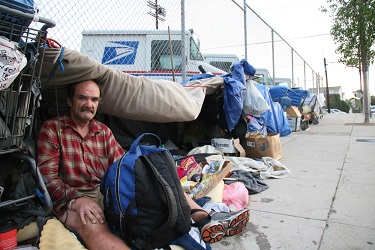Homelessness State Of Emergency Gets Optimistic Response In San Pedro

The number of homeless people living in L.A. rose by 12 percent between 2013 and 2015 and now stands at more than 25,000.
The majority of these, about 17,000 people, are classified as “unsheltered” by the Los Angeles Homeless Services Authority. These “unsheltered” homeless live outside on city streets or in cars and RVs due to a shortage of shelter space.
READ MORE: Civic Hack Night Gathers Downtown Community To Address Homelessness
The increasing size and visibility of the city’s homeless encampments have been a wake up call to neighborhoods that have traditionally seen the issue as a problem for Skid Row. San Pedro, which sits on the southern end of the 110 freeway next to the Port of Los Angeles, is one of these neighborhoods.
Since 2013 the number of homeless living in the Harbor area, which comprises San Pedro, Wilmington, Harbor City and Harbor Gateway, has risen to about 1,500 people, a 25 percent increase since 2013. Between 300 and 400 of these people live in San Pedro specifically.
“The key word is 'noticeable,'” said George Palaziol. “There’s been an increase in the visibility. We had the homeless here [before], they just weren’t visible; they would go and hide.”
Palaziol, who is part of a new San Pedro Homelessness Task Force formed by City Councilman Joe Buscaino, says that the sharp rise in his neighborhood’s homeless population is due in large part to the clean-up of nearby Ken Malloy Harbor Park.
“Once they cleared them out [of the park], where do these people have to go?” he said. “San Pedro seems to take the brunt of it because we have all the services.”
Palaziol welcomes the city’s state of emergency declaration.
“I think it’s about time,” he said. “This money is going to be a huge help.”
But where exactly should that money go? Palaziol says that he wants funds directed toward existing service providers in San Pedro, but resists the idea of building more shelters in the neighborhood.
“I would definitely like to see that money go towards building something near San Pedro, not necessarily in San Pedro,” he said. “Another place would be like opening the welcome mat to more homeless people.”
“There will be one [shelter] in San Pedro,” Hilda said. “It’s just a matter of finding the right property and moving everyone on to it.”
She says that sheltering the homeless in unfamiliar neighborhoods is often so isolating that they will return to living on the street in areas where they feel at home.
While no official plans for new homeless shelters or facilities have been announced for San Pedro, Hilda’s comments are in line with recent statements made by L.A. mayor Eric Garcetti. On Tuesday, during an appearance on the radio show Airtalk, Garcetti stated his support for a decentralized approach to helping the homeless.
“People want to stay in the communities where they are, even if they’re homeless,”said Garcetti. “We need to give them the services where they are.”
Garcetti called for an additional $100 million every year towards the building of permanent supportive housing, a service that some homeless advocates say is essential to getting people off the street in the long term.
Karen Ceaser, a longtime homelessness advocate in San Pedro and a former caseworker at the Union Rescue Mission in Skid Row, says that permanent supportive housing along with a “Housing First” strategy is the city’s best bet if it intends to get a return on its investment.
READ MORE: L.A. County Votes To Raise Minimum Wage With No Exemptions
“Provide housing, then you provide services, right on site,” she said. “It’s way cheaper to do that then have them [the homeless] call emergency services.”
The strategy is being credited for a 15 percent drop in San Jose’s homeless population and a 72 percent decrease in the state of Utah.
James Preston Allen, President of the Central San Pedro Neighborhood Council, expressed support for the emergency declaration, but advised City Hall to listen to its neighborhoods.
In a draft letter to the Mayor and City Council, he urged them to use “the advice and energies of the seven neighborhood councils who have formed homeless committees” and to “fully consider the consequences of under-funding such an initiative.”
Where exactly L.A. will get the $100 million is still unknown at this time, as is how the money will be used. To homeless advocates like Ceaser and Hilda, however, the declaration is a sign that City Hall is finally dealing with the reality of homelessness in L.A..
“You can’t escape it, it’s everywhere,” Ceaser said. “It’s long overdue.”
Contact Staff Reporter Kevin Walker here and follow him on Twitter here.



